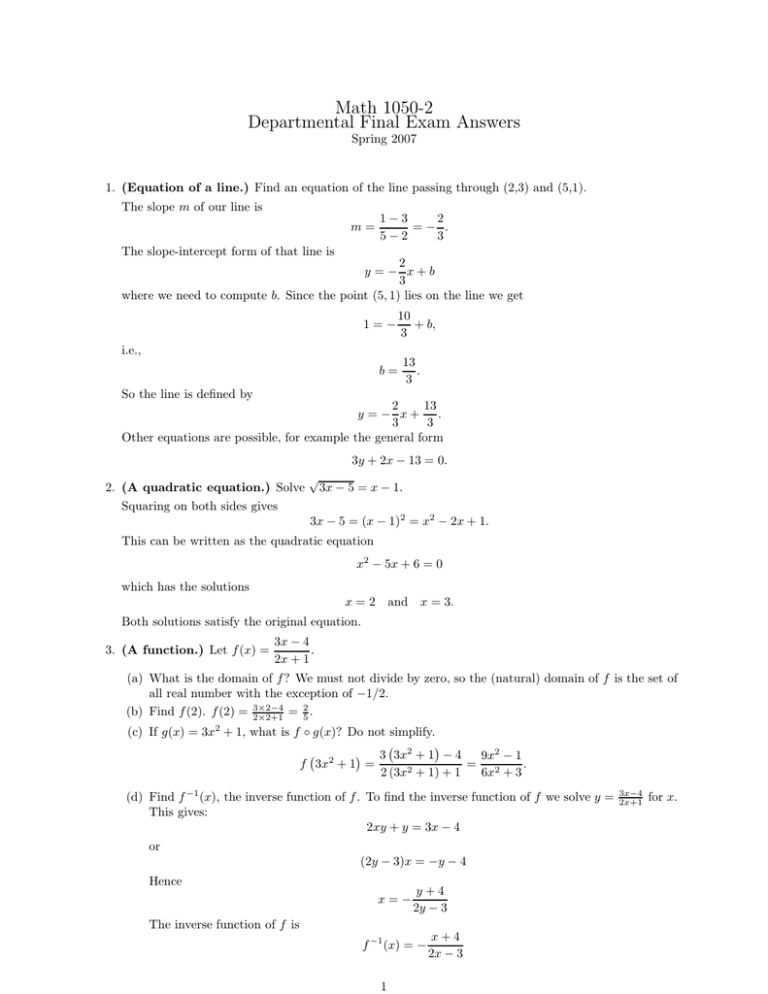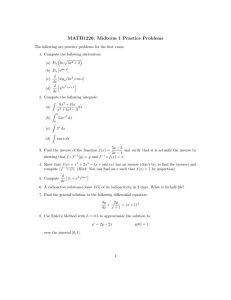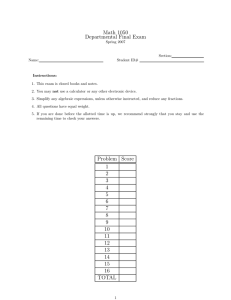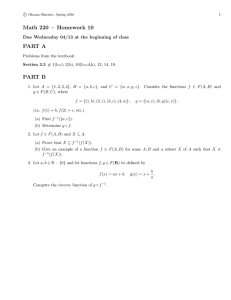Math 1050-2 Departmental Final Exam Answers
advertisement

Math 1050-2 Departmental Final Exam Answers Spring 2007 1. (Equation of a line.) Find an equation of the line passing through (2,3) and (5,1). The slope m of our line is m= The slope-intercept form of that line is 2 1−3 =− . 5−2 3 2 y =− x+b 3 where we need to compute b. Since the point (5, 1) lies on the line we get 1=− i.e., b= 10 + b, 3 13 . 3 So the line is defined by 13 2 y =− x+ . 3 3 Other equations are possible, for example the general form 3y + 2x − 13 = 0. √ 2. (A quadratic equation.) Solve 3x − 5 = x − 1. Squaring on both sides gives 3x − 5 = (x − 1)2 = x2 − 2x + 1. This can be written as the quadratic equation x2 − 5x + 6 = 0 which has the solutions x = 2 and x = 3. Both solutions satisfy the original equation. 3. (A function.) Let f (x) = 3x − 4 . 2x + 1 (a) What is the domain of f ? We must not divide by zero, so the (natural) domain of f is the set of all real number with the exception of −1/2. 3×2−4 = 52 . (b) Find f (2). f (2) = 2×2+1 (c) If g(x) = 3x2 + 1, what is f ◦ g(x)? Do not simplify. 3 3x2 + 1 − 4 9x2 − 1 2 f 3x + 1 = = . 2 (3x2 + 1) + 1 6x2 + 3 (d) Find f −1 (x), the inverse function of f . To find the inverse function of f we solve y = This gives: 2xy + y = 3x − 4 or Hence (2y − 3)x = −y − 4 x=− The inverse function of f is y+4 2y − 3 f −1 (x) = − 1 x+4 2x − 3 3x−4 2x+1 for x. 4. (A linear system.) Solve the following system of equations: x + y + 2z x − 2y − z x−y+z = = −1 2 = 0 Of course this can be solved in many different ways. For example, we may subtract the first equation from the second and the third to obtain: −3y − 3z −2y − z =3 =1 The first equation in this reduced system can be rewritten as y + z = −1 Adding this equation to second equation gives −y = 0 or y = 0. This implies that z = −1 and x = 1: x = 1, y = 0, z = −1. It’s easy to check that these values do satisfy the original set of equations. 5. (Graphing.) Describe how to obtain the graph of g(x) = (x − 1)2 + 2 from the graph of f (x) = x2 by suitable shifts. In the coordinate system below, draw and clearly label the graphs of f and g. We shift the graph of f 2 units up and one unit to the right. The graphs of f and g are shown in Figure 1. The graph of f is the parabola with its vertex at the origin. 10 8 6 y 4 2 –2 –1 1 2 3 x 4 5 6 Figure 1, Two Parabolas 6. (Graphing.) Let f (x) x−1 . x2 − 3x (a) What is the x-intercept? The numerator is zero when x = 1, which gives the x-intercept 1. (b) What are the asymptotes (vertical, horizontal or oblique)? Since the degree of the numerator is less than that of the denominator, the x-axis is a horizontal asymptote. Since the denominator is zero when x = 0 or x = 3, x = 1 and x = 3 are vertical asymptotes. 2 2 y 1 0 –2 2 4 6 x –1 –2 Figure 2, A Rational Function. (c) Sketch the graph of f . The graph of f and its asymptotes are shown in Figure 2. 7. (Simplifying Algebraic Expressions.) Simplify 3x−2 (2x4 )2 . 3x−2 (2x4 )2 = 3x−2 22 x2 4 = 12x8 x−2 = 12x6 . 8. (Logarithm rules.) Use the properties of logarithms to write as a sum, difference, and/or multiple of logarithms: 14x3 log x−5 log 14x3 x−5 = log(14x3 ) − log(x − 5) = log(14) + 3 log(x) − log(x − 5). 9. (Logarithms.) Solve ln x − ln(x − 4) − ln(x − 3) = 0. This is equivalent to ln x (x − 4)(x − 3) Applying the natural exponential on both sides give = 0. x = 1. (x − 4)(x − 3) Multiplying with the denominator and distributing gives x = x2 − 7x + 12. 3 This is the quadratic equation x2 − 8x + 12 = 0 which has the solutions x = 6 and x = 2. In checking the solutions, we see when we let x = 2, we have ln 2 − ln(2 − 4) − ln(2 − 3) = ln 2 − ln(−2) − ln(−1) which is not possible, since we can not have a negative inside a log function. We do not have this problem with x = 6, so our solution is x = 6. 10. (Exponentials.) Solve 2x 2 −5x−1 = 16. Taking the base 2 logarithm on both sides gives the quadratic equation x2 − 5x − 1 = 4 which has the solutions √ 5 3 5 x= ± . 2 2 1 2 1 2 11. (Matrices.) Given that A = , and B = , compute AB. 3 4 1 −1 We obtain AB = 12. (More on matrices.) Let A = system 1 2 −1 2 3 0 7 2 . Compute the inverse of A and use it to solve the linear x + 2y = 0 −x + 2y = 1 To compute the inverse of A we apply Gauss-Jordan Elimination on the augmented matrix: 1 2 −1 2 | 1 0 | 0 1 The inverse matrix is 1 4 2 1 −→ 1 0 2 | 1 4 | 1 −→ 1 0 0 | 1/2 −1/2 4 | 1 1 −→ 1 0 0 | 1/2 −1/2 1 | 1/4 1/4 0 1 R2 ←− R2 + R1 R1 ←− R1 − R2 /2 R2 ←− R2 /4 −2 and the solution of the linear system is 1 1 2 −2 0 −1/2 x = = 1 1/4 y 4 1 1 Thus x=− 1 2 and y= 1 4 which clearly solves the linear system. 13. (Summer fun.) You are running a summer camp with 20 kids. One day you want to send a group of three to go fishing. How many different groups of three are possible? The number N of groups is N= 20 × 19 × 18 20 = 10 × 19 × 6 = 1, 140. = 3×2×1 3 4 14. (Geometric Series.) For this problem, you may leave your answer in the form of an expression involving numbers. You deposit $100 into a savings account at the beginning of each month. The account pays 1% interest per month. It’s most convenient to figure out first how much money is the account after n months. Every month the amount of money in the account earns 1% interest, i.e., we multiply with r = 1.01. The first deposit gets compounded n times, the second n − 1 times, etc. Thus we obtain after n months $100r(1 − rn ) $101(1.01n − 1) An = $100 rn + rn−1 + . . . + r = = = 100 × $101(1.01n − 1). 1−r 0.01 How much money is in your account after 10 years? $100 × 101(1.01120 − 1) = $23, 233.91 The dollar figure is included for your information. Of course you did not need to compute that on the exam. 15. (The Binomial Theorem.) Use the Binomial Theorem to expand and simplify (a − 2b)5 . The Binomial Theorem says (x + y)n = With n = 5, x = a, and y = −2b we obtain: 5 (a − 2b) = 50 a0 (−2b)5 + + 5 4 n X n i n−i xy . i i=0 5 1 1 a (−2b)4 + 5 2 5 5 4 a (−2b)1 + 5 a (−2b)0 2 a (−2b)3 + 5 3 a3 (−2b)2 = −32b5 + 80ab4 − 80a2 b3 + 40a3 b2 − 10a4 b + a5 . 16. (Mathematical Induction.) Use Mathematical Induction to show that the sum of the first n odd numbers equals n2 , i.e., n X (2i − 1) = n2 .(∗) i=1 Let Pn denote the assertion (∗). According to the principle of mathematical induction, we need to verify P1 and then the fact that Pk implies Pk+1 , for all natural numbers k = 1, 2, 3, . . . P1 turns into 1 X i=1 which is true. (2i − 1) = 1 = 12 Pk says k X (2i − 1) = k 2 . i=1 To see that this implies Pk+1 we write k+1 X i=1 (2i − 1) = k X i=1 ! (2i − 1) + 2(k + 1) − 1 = k 2 + 2k + 1 = (k + 1)2 . This completes our proof. 5






